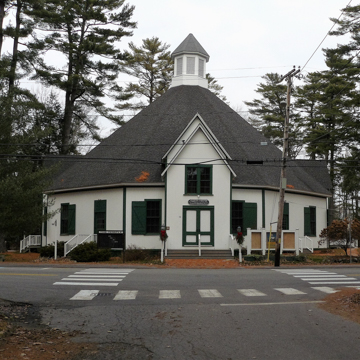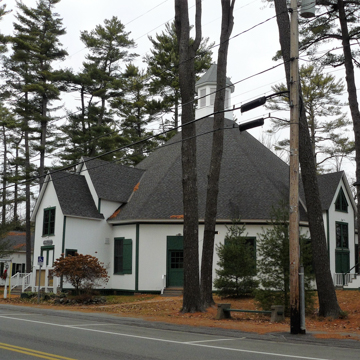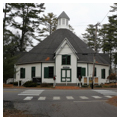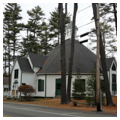Located in the Ocean Park area of Old Orchard Beach, the Temple is Maine’s only octagonal community church. Ocean Park originated in the late nineteenth century as a wholesome, family-oriented, religious-inspired summer colony, which combined vacationing with worship, contemplation, and self-improvement. Established by the Free Will Baptists and led by Bates College President Oren Cheney as part of the Chautauqua movement, the colony was centered on the Temple, which was built in 1881. The area around the building is called Temple Square and also contains several other camp buildings: B.C. Jordan Memorial Hall, Porter Hall, and the Bell Tower.
The Board of Directors of the Ocean Park Association hired the architectural firm Dow and Wheeler to design an octagonal pavilion similar to ones near their congregation in Weirs Beach, New Hampshire. Portland builder James Bickford erected the Temple for a total cost of $3,500. The wood-frame building is two stories high with a hipped roof that culminates in a prominent cupola. Mounted on brick piers, the building is sided in white clapboard. The southernmost facade is composed of three bays. The two-story central bay, which projects from the building, has a double gable roof; a double-hung window is located above the paired doors that serve as the entrance to the church. Three steps lead to the doorway, which is surmounted by a sign reading “The Way of Truth.” Windows are located to the left and right of the projecting central bay.
The facade is flanked on either side by walls containing a door and a window. The east and west walls of the temple are nearly identical in design to the south facade: three bays with a central, two-story, gable-roofed bay projecting outward from the main building. The first story contains a pair of doors, the second a double window. The two walls between the east and west walls, plus the north wall, all have two windows with shutters. From the north wall projects a one-story storage area. The octagonal cupola has eight windows covered with louvered shutters.
The temple’s interior is as stark and barn-like as its exterior—evocative of the nineteenth- and early-twentieth-century revival tent. A speakers’ platform on the north wall, wooden settees, and an organ complete the interior fittings. There have been few alterations to the interior since it was completed. The only significant change was the construction of a stage, built into the rear extension in 1927 to increase seating; this was expanded again in 1986. The temple is still in use as a place of worship and on summer Sundays there is a full schedule of distinguished preachers, including seminary presidents, theologians, and other scholars.
References
Beard, Frank A., and Earle G. Shettleworth, “The Temple at Ocean Park,” York County, Maine. National Register of Historic Places Inventory–Nomination Form, 1975. National Park Service, U.S. Department of Interior, Washington, D.C.
Ocean Park Association. “Ocean Park: Chautauqua-by-the-Sea.” Accessed March 21, 2015. www.oceanpark.org.




